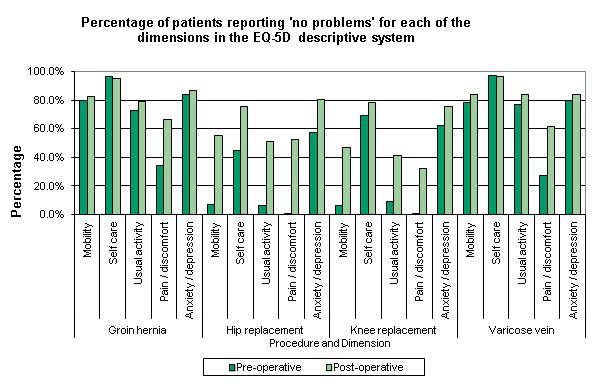IN THIS SITE...

PROMs special topic - EQ-5D Descriptive System
This is the third of a series of PROMs special topics produced on a quarterly basis. The data presented is based on 2009-10, the most current version of finalised data. Further details concerning these data sets can be found via the links on the left-hand side.
The EQ-5D system used in PROMs provides two measures of general pre- and post-operative health, the EQ-5D Descriptive System and EQ visual analogue scale (EQ-VAS). This quarterly Topic of Interest aims to provide users of the PROMs data with an understanding of the changes in the individual components of the EQ-5D descriptive system score between the pre- and post-operative questionnaires.
The EQ-5D Descriptive System of health-related quality of life states consists of five dimensions - mobility, self-care, usual activities, pain/discomfort and anxiety/depression - each of which can take one of three responses. The responses record three levels of severity - no problems/some or moderate problems/extreme problems - within a particular EQ-5D dimension. In the standard publication these five states are combined using weights to give a single headline index measure which ranges from -0.594 to 1, where 1 is the best possible state of health. However this topic paper focuses on the components prior to conversion into an index. Further information regarding the EQ-5D system can be found on the EuroQol Group website.
The 'Key Facts' summarise the national level changes in the five EQ-5D index score components whilst the supporting spread sheet (see below or Related documents on the right) allows users to split the components by various dimensions at national level or view components for a chosen organisation.
Key Facts
Analysis of the EQ-5D Descriptive System components pre- and post-operation for the period April 2009 to March 2010 shows the following:
- Three of the five components for groin hernia indicate little change in the percentage of patients reporting 'no problems'. However patients having 'no problems' with usual activities increases by 6.3 percentage points to 79.1% whilst those reporting 'no problems' with pain/discomfort increases from 34.3% to 66.8%.
- For varicose veins the percentage of patients reporting 'no problems' shows very little change for self-care and an increase of between four and seven percentage points for mobility, usual activities and anxiety/depression. Post-operatively patients reporting 'no problems' with pain/discomfort increases to 61.9% from 27.4% pre-operatively.
- Hip replacement patients report high levels of improvement across mobility, usual activities and pain-discomfort with a percentage point increase of close to 50% for patients reporting 'no problems' post-operation (48.4%, 44.8% and 51.4% respectively). Whilst increases for patients reporting 'no problems' with self-care and anxiety/depression post-operation increases by 30.9% and 23.0% percentage points respectively.
- Patients undergoing knee replacements report percentage point increases of 40.5%, 32.3% and 31.3% relating to experiencing 'no problems' with mobility, usual activities and pain/discomfort respectively. Whilst increases for patients reporting 'no problems' with self-care and anxiety/depression post-operation are 9.3% and 13.5% percentage points respectively.
 |
Supporting information
Responsible statistician
The responsible statistician for this publication is Simon Rhea, HES/SUS Development - Section Head ([email protected], 0845 300 6016).
Copyright statement
The copyright to the information we are disclosing is held by the Health and Social Care Information Centre. The HSCIC has suspended the application of re-use licence fees as a consequence of government policy ('Making Public Data Public'), so you may re-use this information free of charge. Please ensure that the following copyright statement is included within your documents: 'Copyright � 2012 Re-used with the permission of the Health and Social Care Information Centre. All rights reserved.' Please also use the citation logo available for download from the HSCIC's website.
If PROMs data is re-used, please ensure that the appropriate copyright(s) is/are used for each scoring mechanism. Please see the 'Footnotes' page of any PROMs document for further details.

